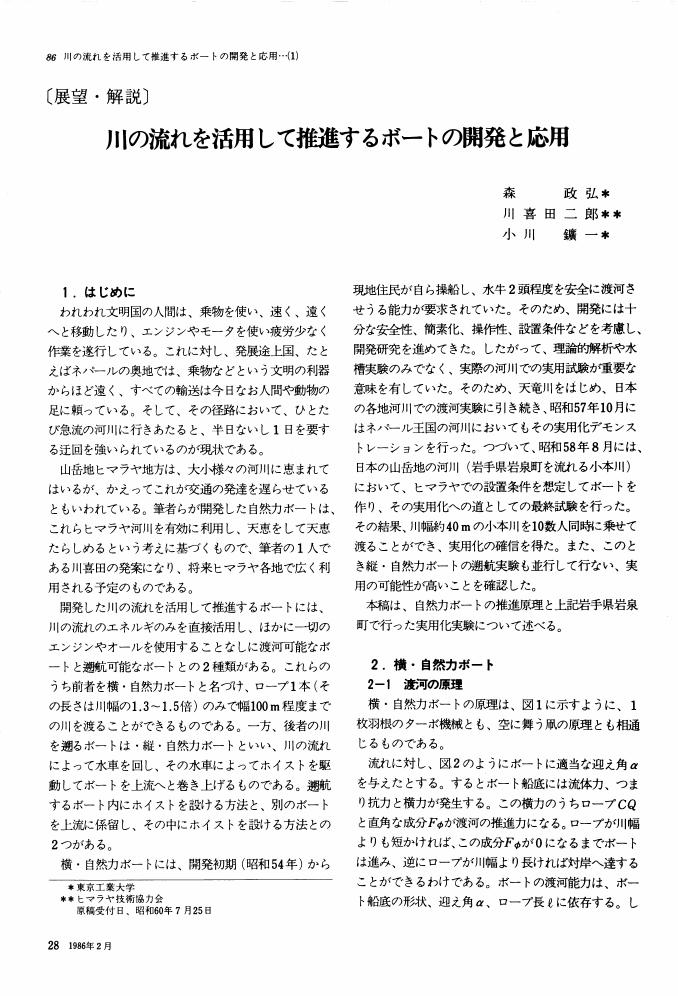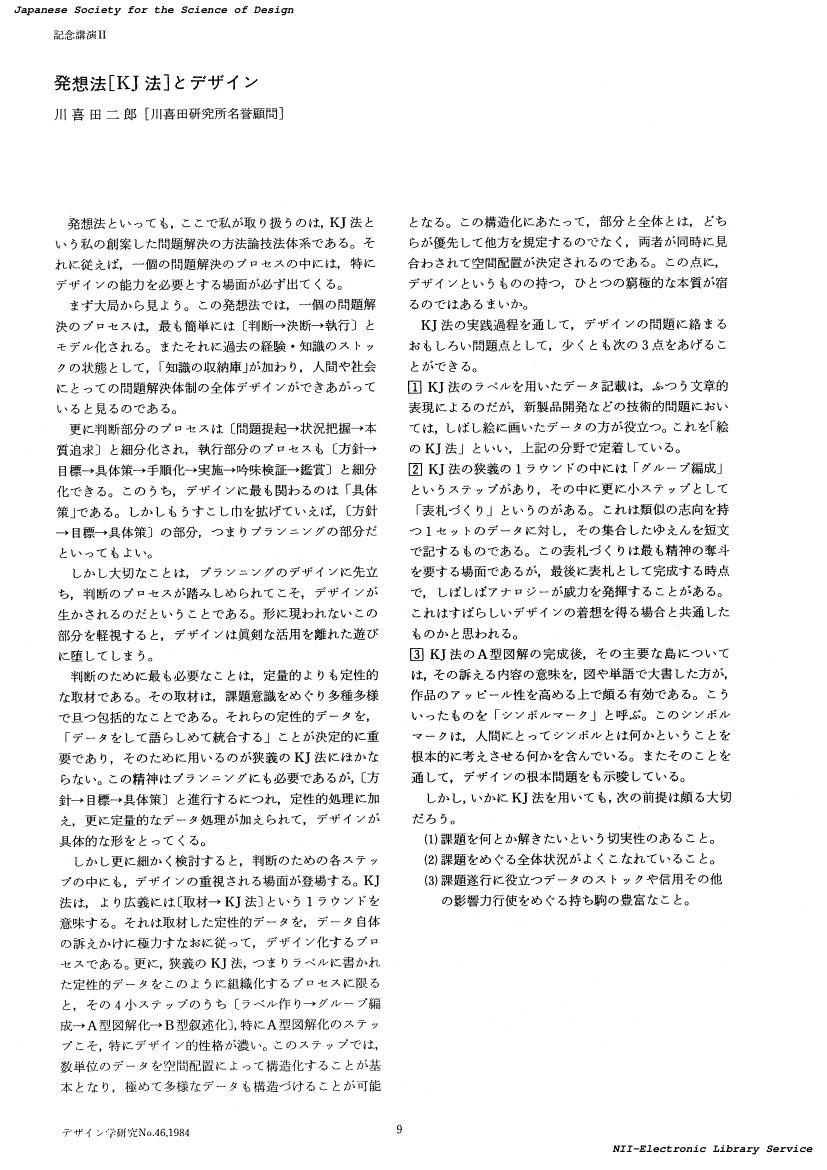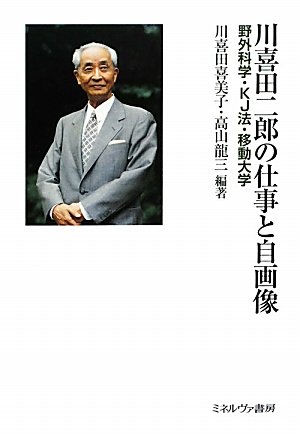45 0 0 0 OA KJ法と啓発的地誌への夢
- 著者
- 川喜田 二郎
- 出版者
- The Human Geographical Society of Japan
- 雑誌
- 人文地理 (ISSN:00187216)
- 巻号頁・発行日
- vol.25, no.5, pp.493-522, 1973-10-29 (Released:2009-04-28)
- 参考文献数
- 15
- 被引用文献数
- 1 3
Geography is a “field science” in the sense that it needs field work. In spite of it, the methodology on field work is not yet satisfactory through various branches of science including geography. Present article is a rough sketch and comments on the personal history of my inquiry into the methodology of field work, especially in the fields of geography and ethnology. In particular, a method of idea generation named KJ Method which was generated by me was explained in detail.For the purpose of recording field data, I devised a form of data card (abbreviated as DC; cf. Fig. 1). In order to classify a file of DC, I tried to adopt the classification table of HRAF (Human Relations Area Files). Soon, however, I understood that classification only was much unsatisfactory for a field worker who sought for true integration of data. Quite different from classification and analysis, another unknown methodology for the purpose of “Facts speak for themselves” must exist.In around 1951, I obtained a first hint for this purpose. And my work “Ethno-Geographical Observations on the Nepal Himalaya” (in Peoples of Nepal Himalaya, ed. by H. Kihara) became the first output along this new method of data processing. Later on, this methodology was greatly improved by myself and named KJ-M. in 1965 by various men. It was a nickname in origin. The first book systematically written on this methodology “Hassôhô” (Abduction) was published in 1967. (cf. References.) This method was welcomed very much, firstly in the fields of company management, business and engineering and gradually in the field of education and science.In the basic KJ-M, there are four essential steps: a) label making, b) label grouping, c) chart making, d) explanation. Label making is to record one concept on a label usually in the form of sentence. (Rarely in the form of any picture.) Surrounding a theme, as rich variety of labels as possible are collected. Label grouping is attained through the repetition of the steps of making teams of labels and title making. Through this process, a number of labels are organized, not by the classification based on some pre-conceived ideas but according to the appeals of original labels. In the step of chart making, these organized labels are spreaded spacially on a sheet according to the recognition of natural relationship among the titles or labels. At last a multi-layered complex relationship between the labels is presented in a chart. Then the last step “explanation” is applied to this chart, i.e. explanatory story making connecting all labels in writings or by verbal explanation.Using the basic KJ-M. repeatedly, we can challenge highly complex problem solvings. A full process of the basic KJ-M. was named “a round”. Multi-round application of this method is called the Cumulative KJ Method (C-KJ). When a C-KJ is applied along the course of problem solving shown in the W-shaped chart (Cf. Fig. 3 and Fig. 7), this method is most fruitful.Using the steps of field work→recording DC→using KJ-M. and C-KJ, chaotic field data can be organized heuristically. The course of data processing is clear and open to anyone who wants to know it. Plenty of hints, hypotheses and generalization arise on the way and in conclusions. These suggestions are not harmful because of subjective judgement but welcomed because of stimuli to readers, as the grounds and processes which bore these suggestions are offered to them frankly. The readers may agree with the author or oppose him. In both cases, both parties will receive desirable stimuli through the dialogue. Thus a basic recognition that data are never facts and the means of observation and data processing intervene between the two leads to the truly scientific and charming geography or ethnography.
6 0 0 0 OA KJ法の原点と核心を語る 川喜田二郎さんインタビュー
- 著者
- 川喜田 二郎 松沢 哲郎 やまだ ようこ
- 出版者
- 日本質的心理学会
- 雑誌
- 質的心理学研究 (ISSN:24357065)
- 巻号頁・発行日
- vol.2, no.1, pp.6-28, 2003 (Released:2020-07-05)
フィールド科学と質的方法論の開拓者であるKJ 法創始者の川喜田二郎さん(1920- )にインタビューをし,現場の語り口を生かして要点をまとめた。KJ 法の発想の原点には,今西学派の特徴である未知への冒険精神と,生きた世界に実践的に関与しながら認識するという根本姿勢があった。方法論の基本的特徴には,次の6 点があげられた。1)現場取材と創造的総合の二つからなるフィールド科学。2)ありのままのデータからボトムアップで認識する方法論。3)フィールドノートではなくカード記述によって自由で多様な組み合せの可能性。4)意味を重視した文章見出しの多段階使用。5)雑多なデータを図解化によって統合。6)図解化と言語化による提示と衆目評価による合意形成。
2 0 0 0 OA 川の流れを活用して推進するボートの開発と応用
- 著者
- 森 政弘 川喜田 二郎 小川 鑛一
- 出版者
- 一般社団法人 ターボ機械協会
- 雑誌
- ターボ機械 (ISSN:03858839)
- 巻号頁・発行日
- vol.14, no.2, pp.86-92, 1986-02-10 (Released:2011-07-11)
- 参考文献数
- 5
1 0 0 0 OA 東シベリヤの乾燥タイガ
- 著者
- 川喜田 二郎
- 出版者
- The Human Geographical Society of Japan
- 雑誌
- 人文地理 (ISSN:00187216)
- 巻号頁・発行日
- vol.2, no.3, pp.25-36,96, 1950-07-30 (Released:2009-04-28)
- 参考文献数
- 20
Eastern Siberia maintains an unique position in Boreal Forest as deciduous coniferous forest. It adapts to the dry and cold winter climate, and Larix spruce represents its characteritics so well. Here, also, there is no evidence of continental glaciers in the past, but permanent tundra exists in place of glaciers. Its main part seems to us as the product of diluvial deposits. From many points of view, the condition of formation is contradictory between glacier and tundra. If the glacial period of diluvium corresponds with the growth period of tundra, both would have maintained their influential spheres separately, without changing their mutual geographical orientation. If each formation periods differ, permanent tundra would due much to the second inter glacier period. In either case, Eastern Siberia experienced no great change since diluvium, but most flourishing period of tundra formation would be coinside with spreading period of loess accumulation and inland basin in southern part of continent.
1 0 0 0 OA アジアの文化領域についての最近の論争
- 著者
- 川喜田 二郎
- 出版者
- 一般社団法人 人文地理学会
- 雑誌
- 人文地理 (ISSN:00187216)
- 巻号頁・発行日
- vol.10, no.2, pp.142-152, 1958-06-30 (Released:2009-04-28)
- 被引用文献数
- 1 1
1 0 0 0 OA 発想法[KJ法]とデザイン(記念講演II,デザインと情報技術,第5回春季大会)
- 著者
- 川喜田 二郎
- 出版者
- 一般社団法人 日本デザイン学会
- 雑誌
- デザイン学研究 (ISSN:09108173)
- 巻号頁・発行日
- vol.1984, no.46, pp.9, 1984-05-17 (Released:2017-07-25)
1 0 0 0 川喜田二郎の仕事と自画像 : 野外科学・KJ法・移動大学
- 著者
- [川喜田二郎著] 川喜田喜美子 高山龍三編著
- 出版者
- ミネルヴァ書房
- 巻号頁・発行日
- 2010
- 著者
- 川喜田 二郎
- 出版者
- 駒沢大学仏教経済研究所
- 雑誌
- 仏教経済研究 (ISSN:02892251)
- 巻号頁・発行日
- no.31, pp.289-305, 2002-05



